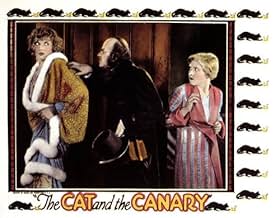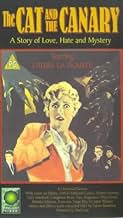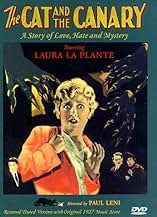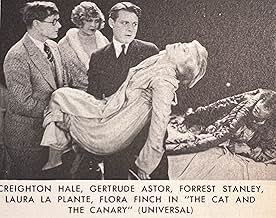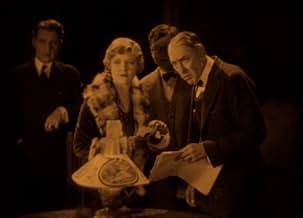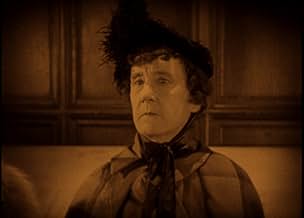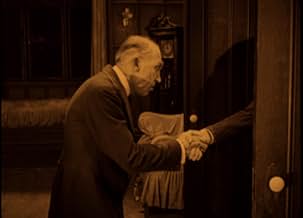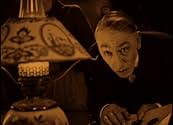IMDb RATING
7.0/10
3.6K
YOUR RATING
Relatives of an eccentric millionaire gather in his spooky mansion on the 20th anniversary of his death for the reading of his will.Relatives of an eccentric millionaire gather in his spooky mansion on the 20th anniversary of his death for the reading of his will.Relatives of an eccentric millionaire gather in his spooky mansion on the 20th anniversary of his death for the reading of his will.
- Awards
- 1 win total
Arthur Edmund Carewe
- Harry Blythe
- (as Arthur Edmund Carew)
Billy Engle
- Taxi Driver
- (uncredited)
Joe Murphy
- Milkman
- (uncredited)
Featured reviews
The millionaire Cyrus West has spent the last years of his life in his mansion nearby the Hudson River considered insane by his greedy relatives and feeling like a canary in a cage surrounded by cats. When he dies, he stipulates that his lawyer Roger Crosby (Tully Marshall) would read his will that is kept in a safe in the twentieth anniversary of his death. On the scheduled day, Cyrus West's loyal servant Mammy Pleasant (Martha Mattox) and the lawyer welcome the guests in the creepy mansion that people tells that is inhabited by ghosts: West's nephews Harry Blythe (Arthur Edmund Carewe), Charles "Charlie" Wilder (Forrest Stanley), the scared Paul Jones (Creighton Hale), Aunt Susan Sillsby (Flora Finch), Cecily Young (Gertrude Astor) and West's niece Annabelle West (Laura La Plante). When Roger Crosby opens the will, West's mansion and fortune are left to the most distant relative having the name West, meaning Annabelle. However, she should prove first that she is sane; otherwise, the inheritance would be bequeathed to another heir whose name is in a sealed envelope. Out of the blue, a guard (George Siegmann) comes to the mansion and tells that a dangerous lunatic has fled from an institution. During the night, Roger Crosby disappears and Annabelle receives an envelope from Mammy Pleasant where West tells the location of his precious diamonds. Annabelle finds the jewels and wears a necklace, but while she is sleeping, a hand comes from the wall and steals the diamonds from her neck. With the exception of Paul Jones that loves Annabelle, her relatives believe that she is insane. But when Annabelle finds a hidden chamber in the wall with the body of Roger Crosby, Mammy Pleasant decides to call the police and the identity of the lunatic is disclosed.
"The Cat and the Canary" is a creepy mystery and horror silent film by the German Expressionist director Paul Leni. The plots blends black humor with elements of horror using the atmosphere of the expressionism with shadows and lighting, and the result is a stylish movie where even the inter-titles are funny. The beauty of Laura La Plante is very impressive. My vote is eight.
Title (Brazil): "O Gato e o Canário" ("The Cat and the Canary")
"The Cat and the Canary" is a creepy mystery and horror silent film by the German Expressionist director Paul Leni. The plots blends black humor with elements of horror using the atmosphere of the expressionism with shadows and lighting, and the result is a stylish movie where even the inter-titles are funny. The beauty of Laura La Plante is very impressive. My vote is eight.
Title (Brazil): "O Gato e o Canário" ("The Cat and the Canary")
The 1922 play THE CAT AND THE CANARY was so popular that it made the fortune of author John Willard, who lived to see it filmed no fewer than three times before his death in 1942. Even today the story remains a classic of its kind, inspiring a host of films that mix comedy, mystery, and horror--not to mention still more that focus on suspicious doings in old, dark houses. When questioned by author Gavin Lambert, director James Whale very specifically indicated that the 1927 film version, along with the 1928 THE LAST WARNING, influenced his own work in such films as FRANKENSTEIN and THE OLD DARK HOUSE.
Both THE CAT AND THE CANARY and THE LAST WARNING were created for Universal by director Paul Leni. But while THE LAST WARNING is not presently available to the home market, THE CAT AND THE CANARY most certainly is, and even some eighty years later is possible to see what all the fuss was about. In term of cinematography, CAT is a remarkably imaginative film, using a series of over-lapping images, close-ups, and dissolves to astonishing effect. In a visual sense it is easily one of the most stylish films of the silent era.
The plot is a classic of its kind. Like the original Willard play, the film's story mixes a host of already-clichéd ideas with several then-new ones. Today, of course, it can be a bit difficult to them apart! But even so it remains a fair amount of fun. An eccentric millionaire has been hounded to death by his greedy relatives--and when he dies he leaves behind a will that imposes a twenty year waiting period between his death and delivery of his estate to his heir. But who will the heir be? The candidates assemble to hear the will at midnight... and no sooner is the heir named than strange doings are afoot.
The characters are archetypes: the nice girl (Laura La Plante), the mild-mannered boy (Creighton Hale), the fashion princess (Gertrude Astor), the battle ax matron (Flora Finch), and so on. Perhaps most memorable is the housekeeper (Martha Mattox), an exceedingly dour woman most ironically named Mammy Pleasant! Add in an exasperated lawyer, a creepy doctor, secret passages, hairy hands with needle-like finger nails, stolen diamonds, and as many dashes of comedy as you can get away with, mix well, and you have the inspiration for a seemingly endless list of classic films.
Although they may seem overly broad by modern standards, the cast plays at the level of what was considered comic-realistic in the late silent era, the production values are first rate, and the plot is quirky enough in a silly sort of way to make the whole thing fun. But it is really the direction and the look of the thing that scores; in its best moments, THE CAT AND THE CANARY is plenty good indeed.
The film is available in several DVD releases. You should avoid the Alpha release; although the picture is passable, the score is so dire that it completely undermines the film. Although it clearly needs further restoration, the Image release is superior and offers your choice of scores, both of which work with the film rather than against it. Recommended for silent fans and those interested in the development of the classic horror film!
Gary F. Taylor, aka GFT, Amazon Reviewer
Both THE CAT AND THE CANARY and THE LAST WARNING were created for Universal by director Paul Leni. But while THE LAST WARNING is not presently available to the home market, THE CAT AND THE CANARY most certainly is, and even some eighty years later is possible to see what all the fuss was about. In term of cinematography, CAT is a remarkably imaginative film, using a series of over-lapping images, close-ups, and dissolves to astonishing effect. In a visual sense it is easily one of the most stylish films of the silent era.
The plot is a classic of its kind. Like the original Willard play, the film's story mixes a host of already-clichéd ideas with several then-new ones. Today, of course, it can be a bit difficult to them apart! But even so it remains a fair amount of fun. An eccentric millionaire has been hounded to death by his greedy relatives--and when he dies he leaves behind a will that imposes a twenty year waiting period between his death and delivery of his estate to his heir. But who will the heir be? The candidates assemble to hear the will at midnight... and no sooner is the heir named than strange doings are afoot.
The characters are archetypes: the nice girl (Laura La Plante), the mild-mannered boy (Creighton Hale), the fashion princess (Gertrude Astor), the battle ax matron (Flora Finch), and so on. Perhaps most memorable is the housekeeper (Martha Mattox), an exceedingly dour woman most ironically named Mammy Pleasant! Add in an exasperated lawyer, a creepy doctor, secret passages, hairy hands with needle-like finger nails, stolen diamonds, and as many dashes of comedy as you can get away with, mix well, and you have the inspiration for a seemingly endless list of classic films.
Although they may seem overly broad by modern standards, the cast plays at the level of what was considered comic-realistic in the late silent era, the production values are first rate, and the plot is quirky enough in a silly sort of way to make the whole thing fun. But it is really the direction and the look of the thing that scores; in its best moments, THE CAT AND THE CANARY is plenty good indeed.
The film is available in several DVD releases. You should avoid the Alpha release; although the picture is passable, the score is so dire that it completely undermines the film. Although it clearly needs further restoration, the Image release is superior and offers your choice of scores, both of which work with the film rather than against it. Recommended for silent fans and those interested in the development of the classic horror film!
Gary F. Taylor, aka GFT, Amazon Reviewer
I'm a fan of both horror films and silent films, but I didn't have a chance to get around to this one until now--and I was surprised by how much I enjoyed it. Other reviewers have already indicated how well-directed it is, and some have pointed out that the "overacting" is intentional in what was always understood by 1927 audiences as a spoof of the "Old Dark House" genre that was popular on Broadway for much of the decade and spilled onto the movie screen. Once you understand that everyone KNEW these were cliches, you realize there's no reason to take a patronizing attitude. I have to say this is the most satisfying "ODH" film I've seen (not considering actual haunted house films like the first version of "The Haunting"). It has a light touch and almost every shot makes some delightful choice--moving camera, jarring close-up, dutch angle, etc. Director Leni succeeds in making this stage play seem cinematic. One shot has a frightened character speeding through the corridor, apparently on an unseen bicycle! The shot of the body falling down out of a closet onto the camera has been much imitated, both seriously (as in "Public Enemy") and as parody (Warner Bros. cartoons). For a quick comparison, check Roland West's early talkie "The Bat Whispers." Although nothing in "Cat" reaches quite the level of West's most astonishing shots, the film as a whole is more satisfying and less stagey.
This late silent movie shows off the considerable talents of its director, Paul Leni, as the camera prowls the environs of an old dark house with the gracefulness of a cat, while the actors bob around like canaries, forming uneasy alliances and plotting against one another. The cast is well chosen. Laura La Plante makes a lovely heroine, while bespectacled Creighton Hale makes an agreeable, somewhat Harold Lloyd-like hero. Tully Marshall and Martha Mattox represent, none too flatteringly, the older generation; the former has the face of a drawn, white prune, while the latter makes a perfect battle-axe as the ironically named Mammy Pleasant. By today's standards the movie isn't too scary, though its mood of foreboding is still effective. Its qualities are pictorial more than dramatic, and the print I saw was badly in need of restoration.
The Cat and the Canary is a key film of the silent era, and was hugely influential in kicking off the old dark house genre that continued into the early talkie period. When sound came in the wisecracks proliferated, which tended to lighten the mood and detract from the suspense. In this one the humor is visual, and the tone is more consistent. There have been dozens remakes and imitations over the years, but the dark, Gothic beauty of the original has never been surpassed.
The Cat and the Canary is a key film of the silent era, and was hugely influential in kicking off the old dark house genre that continued into the early talkie period. When sound came in the wisecracks proliferated, which tended to lighten the mood and detract from the suspense. In this one the humor is visual, and the tone is more consistent. There have been dozens remakes and imitations over the years, but the dark, Gothic beauty of the original has never been surpassed.
This is the stereotypical old dark house movie, all the relatives come to and old dark house and some one begins to kill them, or tries to. This has been remade several times, each version having its flaws and its strengths. This is the first version, and while I would like to say its the best, I can't since the silent medium has rendered its pace a bit too slow for modern audiences.
This isn't to say that its a bad film. Its not. Anyone interested in film and what can be done with it should see this film because the first half of this movie is a treasure trove of cinema techniques. The first half is also a damn good movie as well since it wonderfully sets everything up. Only as things begin to follow there course does the pacing slow. Its far from bad, it just may have you look at your watch now and again.
I give it seven out of ten, not perfect but watchable.
This isn't to say that its a bad film. Its not. Anyone interested in film and what can be done with it should see this film because the first half of this movie is a treasure trove of cinema techniques. The first half is also a damn good movie as well since it wonderfully sets everything up. Only as things begin to follow there course does the pacing slow. Its far from bad, it just may have you look at your watch now and again.
I give it seven out of ten, not perfect but watchable.
Did you know
- TriviaWriter/director Robert F. Hill not only wrote the adaptation for this film but also served as a sort of assistant/associate director for Paul Leni. Leni, a German, didn't speak much English, and Hill spoke German, so he acted as a liaison between Leni and the cast and crew.
- GoofsAs Tully Marshall's dead body falls to the floor, the actor can be clearly seen extending his hands to break the fall.
- Quotes
Roger Crosby: I have come to read the will of Cyrus West. Have any of the heirs arrived yet?
Mammy Pleasant: No, Mr. Crosby.
Roger Crosby: You must have been lonely here these twenty years, Mammy Pleasant.
Mammy Pleasant: I don't need the living ones.
- Crazy creditsThe ending cast list includes the following statement: "This is repeated at the request of picture patrons who desire to check the names of those players whose work has pleased them."
- Alternate versionsKino International distributed a video with the original 1927 musical setting compiled by James Bradford and adapted and performed by Eric Beheim and "The Cyrus West Players." It was produced by David Shepard using film materials from the David Bradley collection, and copyrighted in 1997 by Film Preservation Associates. The running time was 82 minutes.
- ConnectionsEdited into Histoire(s) du cinéma: Seul le cinéma (1994)
- SoundtracksSymphony No. 3 in C minor Op. 78 'Organ' I. Adagio
Written by Camille Saint-Saëns
- How long is The Cat and the Canary?Powered by Alexa
Details
- Release date
- Country of origin
- Languages
- Also known as
- The Cat and the Canary
- Filming locations
- Production company
- See more company credits at IMDbPro
Box office
- Gross US & Canada
- $709,699
- Runtime1 hour 48 minutes
- Color
- Sound mix
- Aspect ratio
- 1.33 : 1
Contribute to this page
Suggest an edit or add missing content


